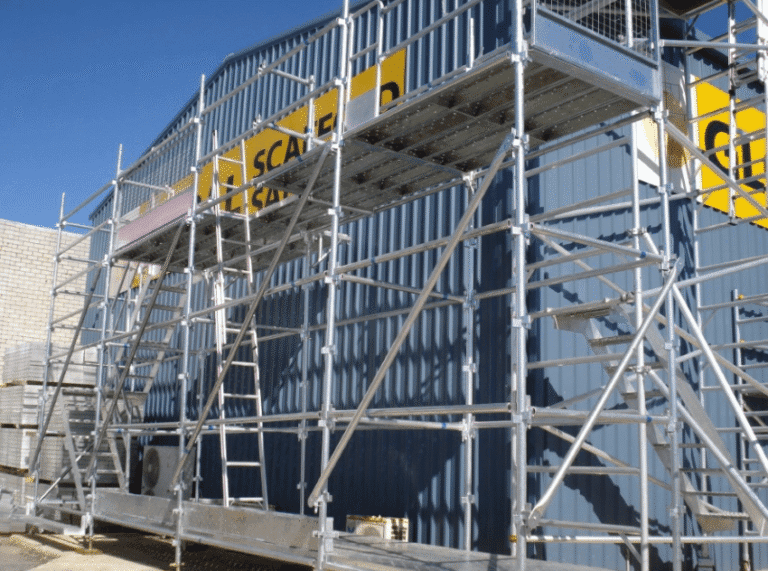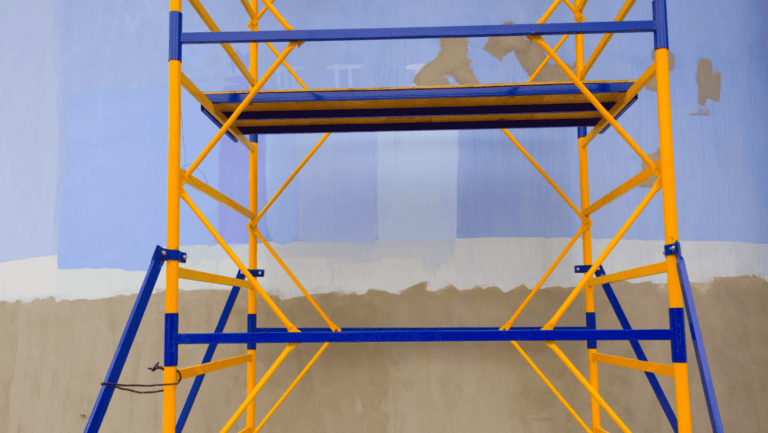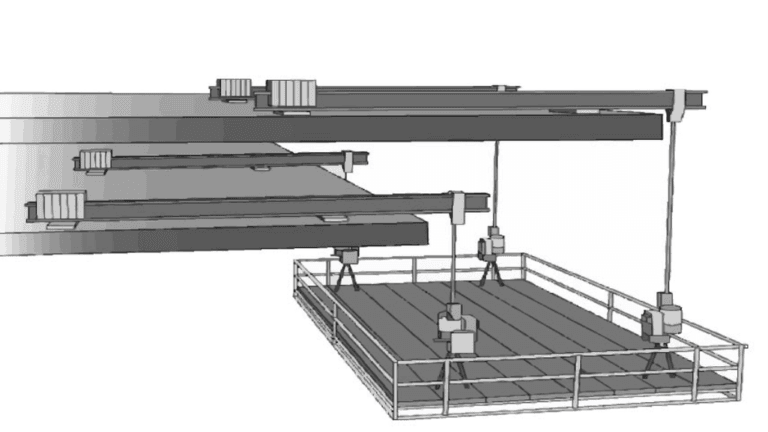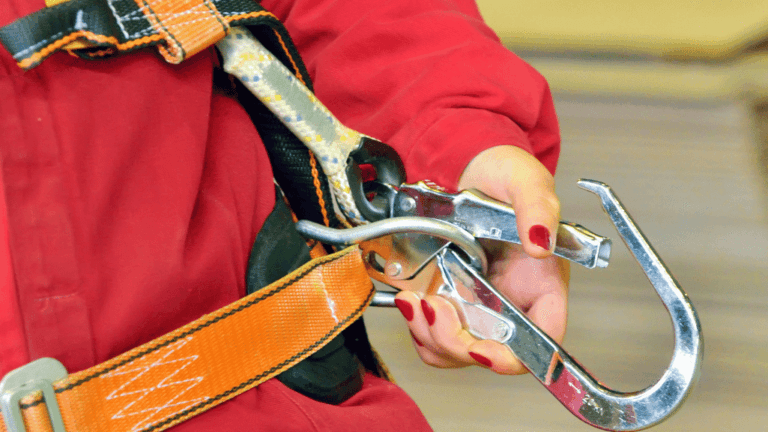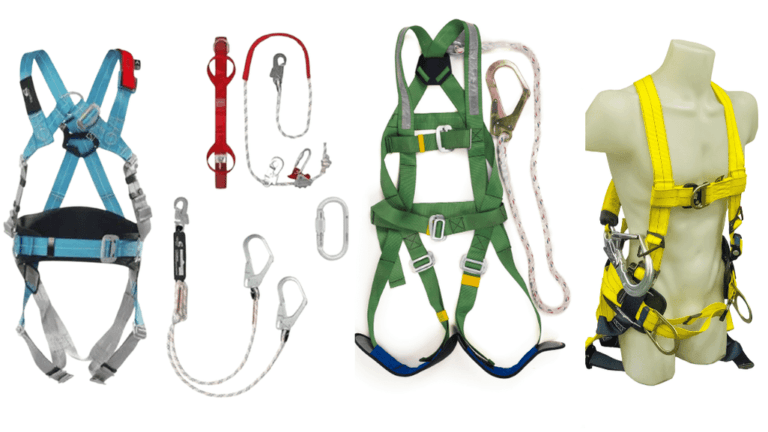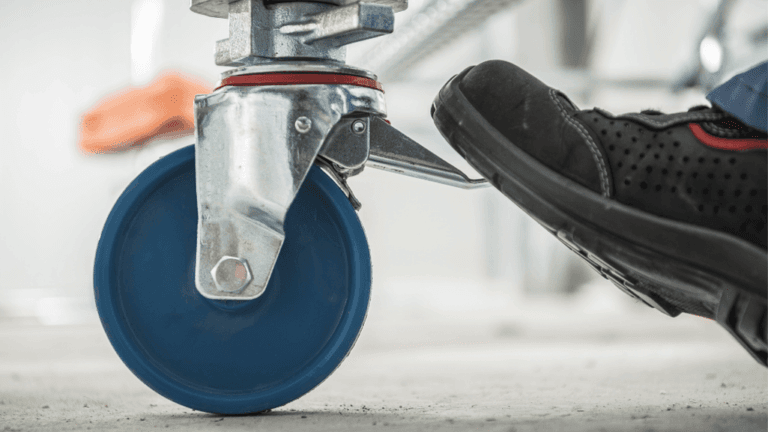Phone:
(+65)8319-0742
Scaffold access is key to scaffolding safety in construction. It’s vital for workers to have safe access to scaffolding equipment. This access allows workers to safely reach and move around the structure.
Supported scaffolds are platforms held up by rigid supports like poles and frames. These are anchored to the ground for stability. OSHA requires workers to be trained in using these scaffolds safely. A “scaffold expert” must always be present to ensure safety and handle any issues.
Every year, about 4,500 workers get injured on scaffolds, and 50 die. To keep workers safe, it’s important to have the right scaffold access. Following safety guidelines for inspection, use, and maintenance is crucial.
Key Takeaways
- Scaffold access is essential for workers to reach the working platform and move around the structure securely.
- Supported scaffolds are platforms held up by rigid supports anchored to the ground for stability.
- OSHA requires workers who use supported scaffolds to be trained in proper use, placement, assembly, disassembly, material handling, and fall prevention.
- A “scaffold expert” must be onsite at all times when a scaffold is being erected or used.
- Approximately 4,500 workers suffer scaffolding injuries annually, and around 50 workers die each year as a result of scaffolding accidents.
Types of Scaffolds
Scaffolding comes in two main types: supported and suspended scaffolds. Both help workers reach high places, but they’re built differently. Knowing the differences is key to picking the right equipment and keeping workers safe.
Supported Scaffolds
Supported scaffolds are the most used in construction and industry. They have platforms supported by strong parts like poles and frames. Their stability comes from a solid base and correct setup.
Some well-known supported scaffolds are:
- Frame or Fabricated Frame Scaffolds
- Ladder Jack Scaffolds
- Mast Climber Scaffolds
- Pump Jack Scaffolds
- Specialty Scaffolds (Plasterers’, Decorators’, and Large-Area Scaffolds)
Recently, scissor lifts and aerial lifts have joined supported scaffolds. They offer quick access to high places and are used in many fields.
Suspended Scaffolds
Suspended scaffolds, or swing stages, hang from ropes. They’re great for exterior work like window washing and painting.
Common suspended scaffolds include:
- Two-Point Adjustable Suspension Scaffolds
- Single-Point Adjustable Suspension Scaffolds
- Catenary Scaffolds
- Multi-Point Suspension Scaffolds
- Interior Hung Scaffolds
Suspended scaffolds are easy to adjust and move. But, they need careful weight management and safety checks to avoid accidents.
Choosing the right scaffold depends on the job, the height, and how long it’ll take. Always follow OSHA rules and train workers well, no matter the type of scaffold.
Designated Areas of Access
Workers must use specific areas to access scaffolds safely. These include access ladders, ramps, walkways, and stairway towers. They are designed for stable footing and to reduce fall risks.
Access Ladders
Access ladders are a common way to reach scaffolds. They must be securely attached to the scaffold. This ensures they can support workers safely.
Inspect ladders regularly for damage or wear. Fix any issues quickly to keep the work area safe.
Ramps and Walkways
Ramps and walkways offer an alternative to ladders. If they are over six feet high, guardrails are needed to prevent falls. The surface should be slip-resistant and clear of obstacles.
Walkways should be at least 18 inches wide. This allows for easy movement of workers and equipment.
| Access Type | Height Requirements | Safety Measures |
|---|---|---|
| Ramps | 6 feet or more above ground | Guardrails, slip-resistant surface |
| Walkways | 6 feet or more above ground | Guardrails, minimum width of 18 inches |
Stairway Towers
Stairway towers are convenient for accessing scaffolds, especially when carrying tools. They connect directly to the scaffold and have stairs with handrails. The stairs have a non-skid surface to prevent slips.
Stairway towers are great for big scaffolding projects. They make moving between levels easier.
According to OSHA regulations, stairway towers used for scaffold access must be designed and constructed in accordance with the manufacturer’s specifications and applicable standards.
Using designated areas like ladders, ramps, walkways, and stairway towers ensures safe access to scaffolds. Regular checks and maintenance are key to safety and following regulations.
Inspection Correct Use and Maintenance of Accesses
Regularly checking scaffolds, using them correctly, and keeping access areas safe are key to avoiding accidents. In 2020, the Bureau of Labor Statistics reported 52 scaffolding deaths. This shows how vital it is to follow safety rules in the scaffolding field. Daily checks for damage or defects in access areas are a must, and any issues should be told to a supervisor right away.
Workers should only use approved ways to get to scaffolds, like ladders and ramps. Climbing on cross-braces is a big no-no as it can make the scaffold unstable. OSHA says that people working on scaffolds need special training, as stated in 29 CFR 1926.454(b) and 29 CFR 1926.
Keeping access areas clean and clear of clutter is also crucial. This helps prevent slips, trips, and falls. Employers must also train workers again when new dangers show up, as 29 CFR 1926.454(c) requires. Not following OSHA’s rules can lead to fines, job shutdowns, and even injuries.
Circle Safety & Health Consultants offer a five-hour Competent User/Inspector Course to meet OSHA scaffolding requirements, promoting safety in the industry. They recommend recertification every five years for competent person training.
To keep scaffolds safe, it’s important to:
- Do daily checks on scaffold access areas
- Use only approved ways to get to scaffolds
- Keep access areas clean and clear
- Train scaffolding experts properly
- Train workers again when new dangers appear
| Requirement | OSHA Standard |
|---|---|
| Scaffolding competent person training | 29 CFR 1926.454(b) and 29 CFR 1926.454(a) |
| Employee retraining when new hazards arise | 29 CFR 1926.454(c) |
| Scaffolds must bear at least four times the maximum intended load | OSHA standards for scaffolding in the construction industry |
By focusing on scaffold checks, proper use, and keeping access areas safe, employers can make workplaces safer. This reduces accident risks and follows OSHA rules. Investing in good training, like what Impact Safety and Circle Safety & Health Consultants offer, can also boost scaffold safety.
Protection Against Falling Objects
Keeping workers and bystanders safe from falling objects is crucial on scaffolds. Tools, materials, or debris can fall and hurt people or damage things. To keep everyone safe, we use safety gear and preventatives.
OSHA rules say scaffolds need toe-boards, screens, and more to stop falling objects. These safety steps help avoid accidents and injuries.
Toe-boards
Toe-boards help stop tools and materials from falling off scaffolds. They must be at least 3.5 inches tall and have small gaps. This keeps small objects from falling off.
Screens and Debris Nets
Screens and debris nets add extra safety when toe-boards aren’t enough. Screens catch falling objects, and debris nets catch them before they hit the ground. These are great for catching tools or small materials.
For heavy objects, we rope off the area below. This keeps people safe even if the nets or screens fail.
| Protective Measure | Description | OSHA Requirements |
|---|---|---|
| Toe-boards | A barrier placed along the edge of a scaffold platform to prevent objects from falling | At least 3.5 inches tall; gap no larger than 0.25 inches between bottom and platform; maximum 1-inch opening if not solid |
| Screens | Mesh or netting material installed along the outer edge of scaffolds to catch falling objects | Must be capable of withstanding the impact of potential falling objects |
| Debris Nets | Nets hung below platforms and walkways to intercept falling objects | Must be capable of catching moderately weighted objects; area below must be roped off for heavy objects |
Using toe-boards, screens, and debris nets greatly reduces falling object risks. Regular checks and upkeep are key. As the scenery scaffolding field grows, keeping objects from falling is a top priority for safety.
Fall Protection Measures
Keeping workers safe on scaffolds is very important. Fall protection is key to avoiding accidents and deaths. OSHA rules require fall protection at heights of 10 feet or more (29 CFR 1926.451(g)(1)). Following these rules is crucial, as scaffolding often tops OSHA’s list of most cited violations.
Guardrails
Guardrails are a main way to prevent falls on scaffolds. They must be set up between 39 and 45 inches above walkways and on all open sides. For masonry scaffolding, guardrails, cross-braces, and rails must be installed correctly to prevent falls. Window washer scaffolding also has specific rules, like needing to be tied off while working on suspended scaffolds.
Personal Fall Arrest Systems (PFAS)
Personal Fall Arrest Systems (PFAS) are also vital for fall protection on scaffolds. PFAS use devices like an anchoring device, body harness, lifeline, and deceleration device to slow and stop falls. For suspended scaffolding, workers must be tied off, with rules varying based on the number of suspension points. The scaffold expert decides if PFAS are safe for erectors and dismantlers.
Fall protection is extremely important, as 89 workers die each year from falls off scaffolds, the BLS reports. Also, about 100 people die annually from falls off ladders, often due to serious violations like not securing a ladder or extending it too far.
| Fall Protection Measure | Key Requirements |
|---|---|
| Guardrails | Installed between 39 and 45 inches above walking surfaces and on all open sides of a scaffold |
| Personal Fall Arrest Systems (PFAS) | Includes anchoring device, body harness, lifeline, and deceleration device; mandatory tie-off for suspended scaffolding |
Training a Competent Person in scaffolding rules is essential. Their knowledge and authority are crucial for compliance and safety. By using proper fall protection and following OSHA rules, employers can greatly reduce fall risks and make work safer for their employees on scaffolds.
Scaffold Construction Procedures
Proper scaffold construction is key for the safety of 2.3 million construction workers. They rely on scaffolds for their jobs. Following OSHA’s advice can greatly lower the risk of accidents and injuries.
Leveling the Area
The first step is to make sure the surface is level and stable. OSHA says the area must support the scaffold and its load without moving. To do this, the site needs to be leveled and any obstacles removed.
Adjustable Screw Jacks and Mud Sills
After leveling, the next step is to attach the scaffold legs to adjustable screw jacks. These jacks let each leg adjust independently. When on the ground, mud sills are used under the jacks to spread the weight.
Using adjustable screw jacks and mud sills is crucial for a stable scaffold. Without proper leveling or base plates, the scaffold can become unstable. This increases the risk of collapse, a major hazard.
According to OSHA, 72% of workers injured in scaffold accidents attribute the incident to planking or support giving way, slipping, or being struck by a falling object.
To lower these risks, it’s vital to follow scaffold construction procedures. This includes using screw jacks and mud sills for leveling. By sticking to OSHA guidelines, employers can greatly reduce the chance of accidents and keep their workers safe.
Installing Scaffold Platforms
Proper scaffold platform installation is key for safety and stability. Platforms must be fully decked with scaffold-grade planks that are at least 18 inches wide. These planks need to be secured to prevent displacement.
When installing, ensure all parts fit well without too much force. Avoid mixing parts from different manufacturers unless a scaffold expert says it’s okay. Mixing metals can cause problems, as harder metals might bend softer ones.
Platforms need to meet specific width requirements. For ladder jack and other scaffolds, the minimum width is 12 inches. But for most scaffolds, it’s 18 inches. Boatswain’s chair scaffolds don’t have a minimum width.
When joining platforms, they should overlap by at least 12 inches. Platform planks must be laid correctly when changing direction. Each platform end should be secured with cleats or hooks.
Scaffold platforms are designed with a 4 to 1 safety factor for load-bearing capacity, ensuring they can support four times the maximum intended load without failure.
Access to platforms over 2 feet high or low should be provided. This can be through portable ladders, stairways, ladder stands, stair towers, ramps, walkways, or integral scaffold access.
- Portable ladders
- Stairway-type ladders
- Ladder stands
- Stair towers
- Ramps
- Walkways
- Integral prefabricated scaffold access
Portable ladders must be placed to avoid tipping the scaffold. They must meet design requirements for spacing and length. Stairway ladders need rest platforms and slip-resistant surfaces. Mobile ladder stands have steps at least 11-1/2 inches wide.
Stair towers have specific design requirements for safe use. Scaffold platforms need guardrails, midrails, and toe boards to prevent falls and protect workers from falling objects. Guardrails on scaffolds made and used after January 1, 2000, should be between 38 and 45 inches high.
By following these guidelines, contractors can create a safe work environment. This reduces the risk of accidents and injuries related to scaffolding work.
Overhead Scaffold Hazards
Working on scaffolds comes with risks from overhead hazards. These include power lines, electrical storms, and high winds. If not careful, these can cause serious harm or even death.
About 65% of construction workers use scaffolds. Electrical dangers come from bad grounding, being near power lines, and damaged tools. These can lead to electrocution if workers don’t watch out.
Power Lines
Power lines are a big risk when working on scaffolds. Cal/OSHA says workers must stay at least 10 feet away from electrical hazards. Make sure the scaffold is grounded and all tools are safe and protected.
A knowledgeable scaffold competent person is required when building, moving, or dismantling a scaffold, and daily inspections are necessary to ensure safety.
Electrical Storms and High Winds
Electrical storms and high winds also pose dangers. It’s best to avoid working on scaffolds in these conditions. High winds can make scaffolds unstable, and storms can cause lightning strikes.
| Overhead Hazard | Safety Measure |
|---|---|
| Power Lines | Maintain a minimum distance of 10 feet between scaffold and power lines |
| Electrical Storms | Avoid working on scaffolds during electrical storms |
| High Winds | Avoid working on scaffolds during high winds |
To stay safe, workers need proper training on scaffolds. This should include lessons on fall, tool, and electrical hazards. Following safety rules and being aware of overhead dangers can greatly reduce risks.
Scaffold Access Includes Which of the Following?
Ensuring worker safety is key on construction sites. Scaffold hazards are a big concern, ranking high in OSHA violations since 2016. In 2020, scaffolding issues caused 3,400 injuries and 56 deaths in the U.S. Knowing about scaffold access types is crucial to avoid these risks.
Scaffold access has several important parts. These are ladders, ramps, walkways, and stairway towers. Using these in scaffold designs and following OSHA rules can lower accident risks.
Ladders
Ladders are a common way to reach scaffolds, especially for heights over two feet. OSHA says ladders must be securely attached and extend three feet above the platform. This ensures a safe transition from ladder to scaffold.
Ramps
Ramps offer a gentle slope for accessing scaffolds, making it easier to move materials. For ramps over six feet high, OSHA requires guardrails to prevent falls. Each scaffold platform and walkway, including ramps, must be at least 18 inches wide for safe movement.
Walkways
Walkways are flat paths connecting scaffold sections, allowing workers to move easily. Like ramps, walkways over six feet high need guardrails. Also, all planking or platforms must overlap twelve inches and be secured to prevent movement.
Stairway Towers
Stairway towers are a stable and efficient way to access scaffolds, compared to ladders. They connect to the scaffold frame and must have safety rails on both sides. Stairway towers are great for projects needing frequent worker and material movement between levels.
To keep the work area safe, scaffold access points must be checked daily. They should be free of debris and clutter. Workers must use these access areas correctly, following all safety rules. By focusing on scaffold access safety, construction companies can protect their workers and reduce accident risks.
Conclusion
Scaffold safety is key in the construction world. Getting the right training is vital to avoid accidents. These can include slips, falls, and being hit by falling objects.
Workers need to know how to spot dangers and follow safety steps. A trained person must oversee the setup, moving, or taking down of scaffolds. This ensures everything is done safely.
To keep scaffolding safe, using OSHA-compliant gates is essential. These gates help prevent falls and have strong locks. They are made to last and easy to see through.
These gates help follow OSHA rules, cut down on accidents, and make work more efficient. They are a must for any construction site.
Scaffold Access Gates are crucial for keeping sites safe. They stop unauthorized entry and protect tools and materials. There are many types, like swing and slide gates, to fit different needs.
Choosing the right gate is important for a safe work area. It depends on the site’s specific needs.
Knowing and following scaffolding safety rules is important. It keeps workers safe and prevents accidents. Training, a competent person, and OSHA-compliant gates are all key to a safe work environment.






